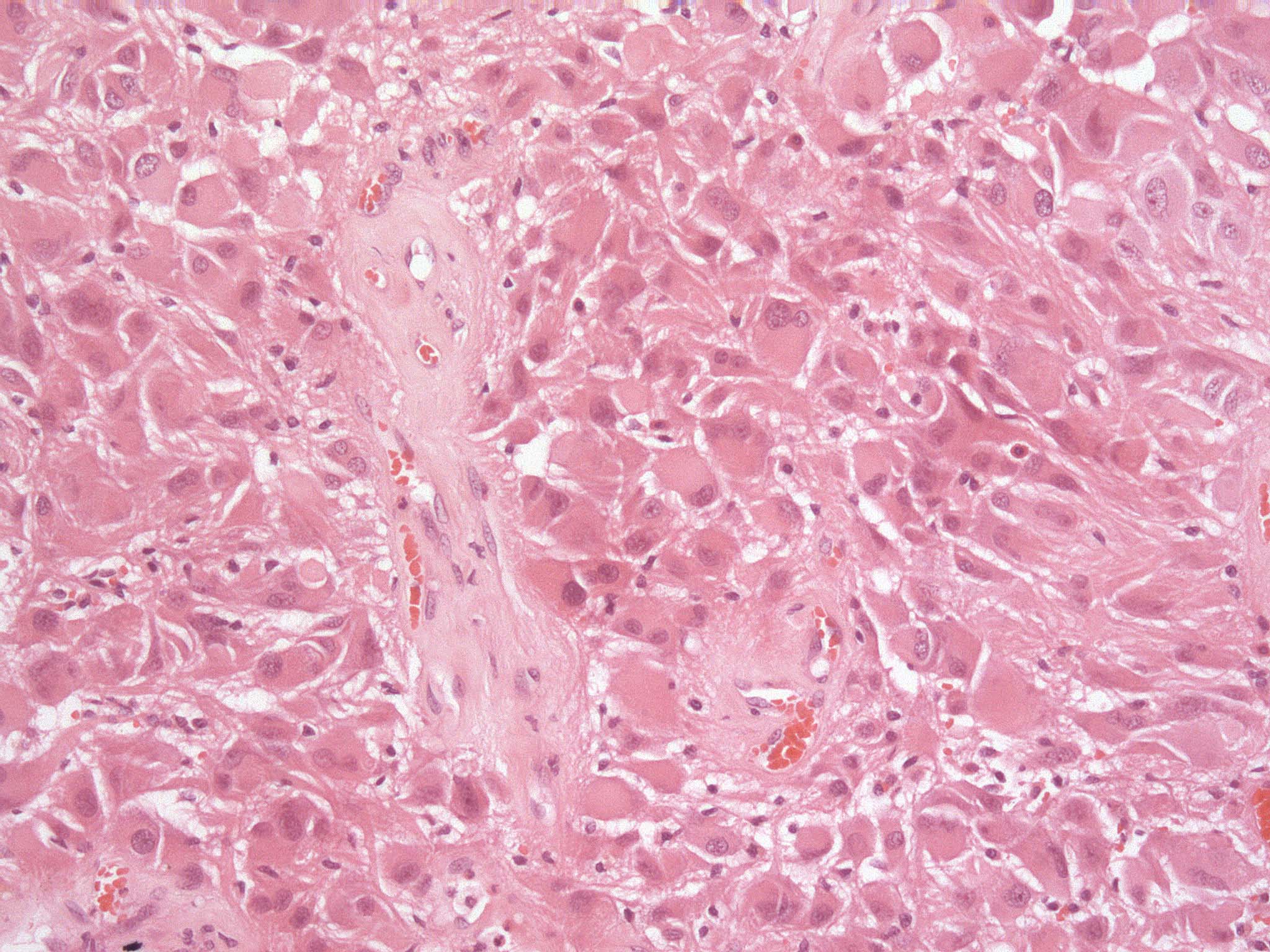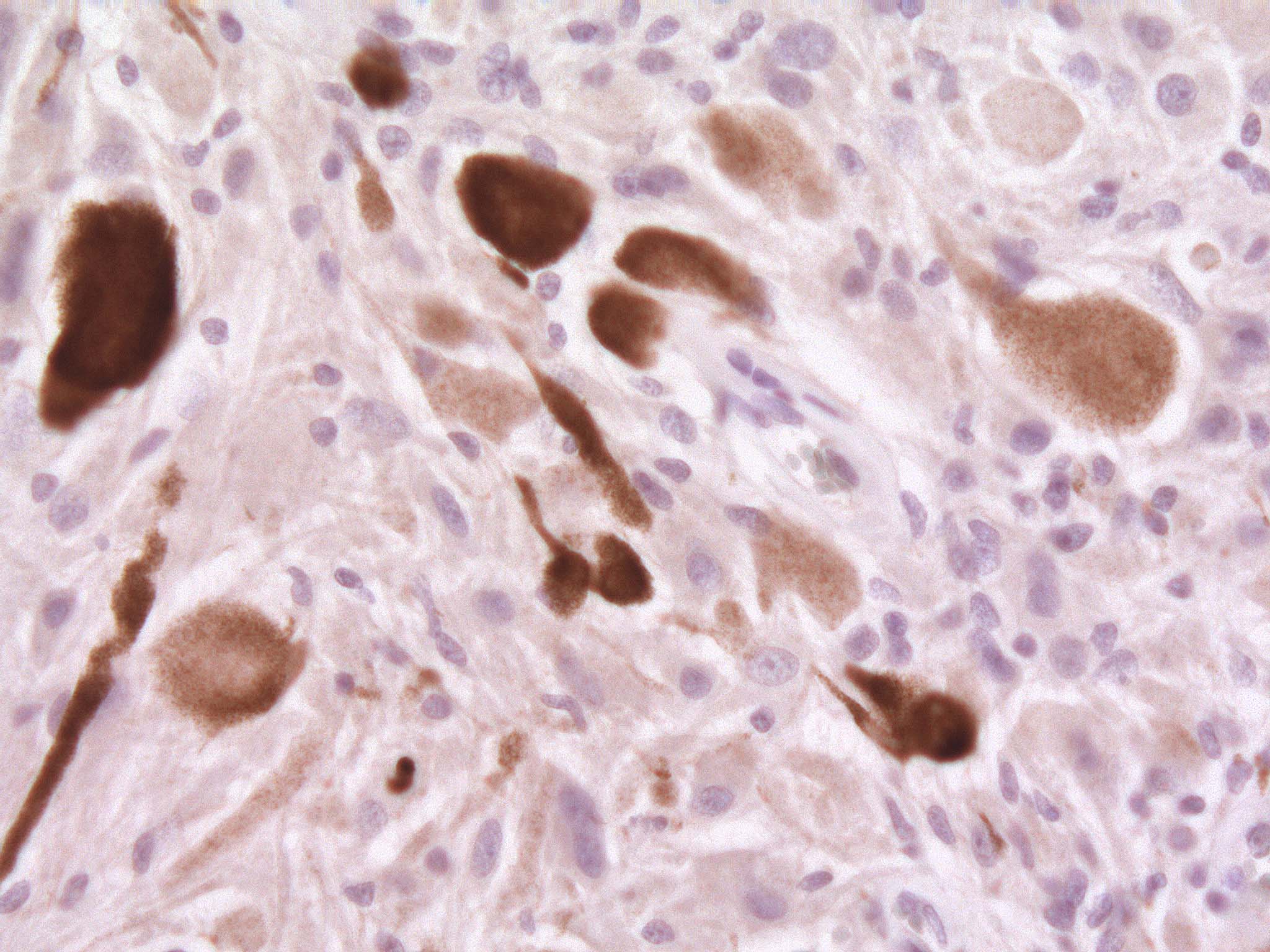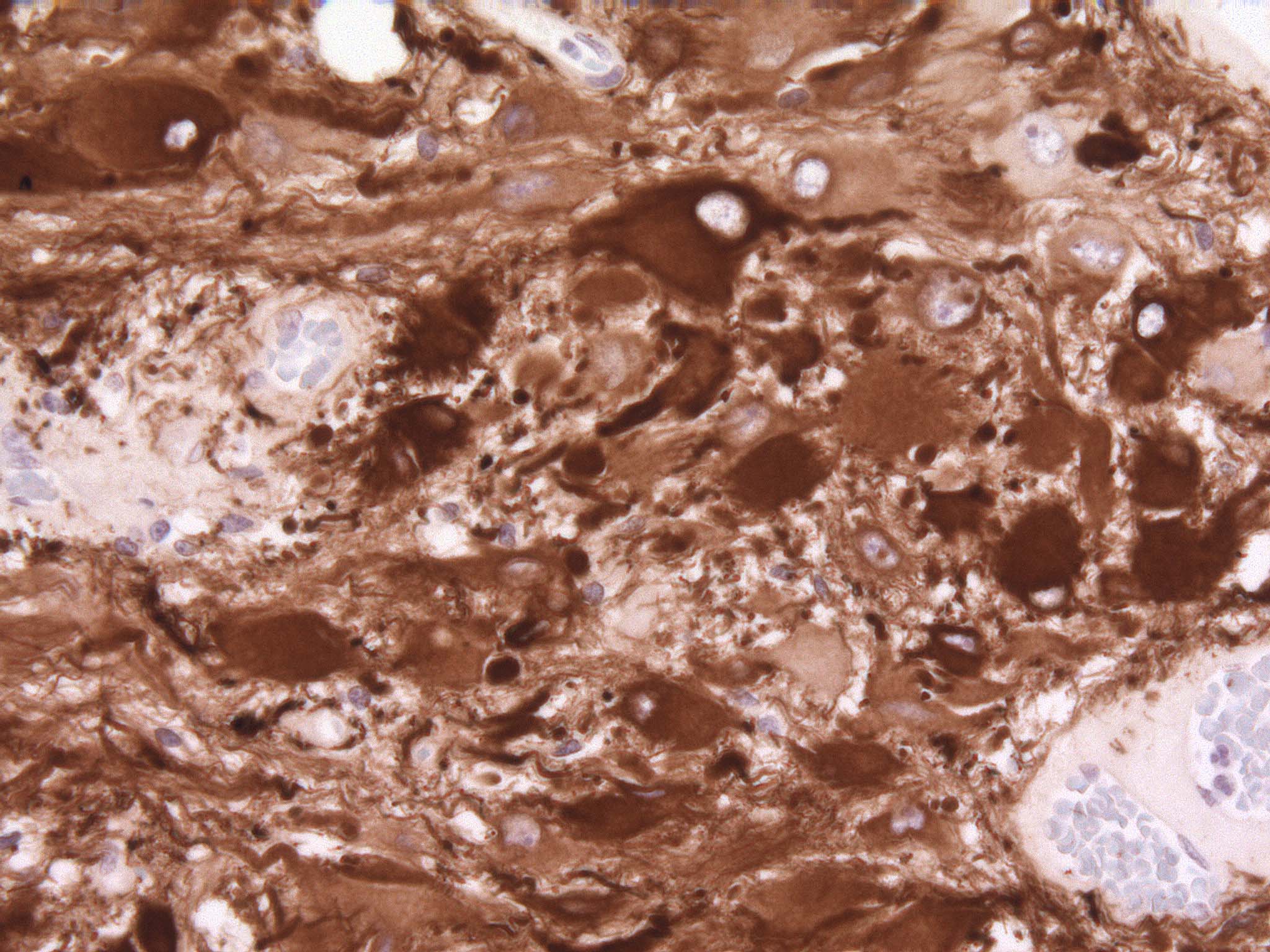Subependymal giant cell astrocytoma pathophysiology: Difference between revisions
| (85 intermediate revisions by 3 users not shown) | |||
| Line 1: | Line 1: | ||
__NOTOC__ | __NOTOC__ | ||
{{Subependymal giant cell astrocytoma}} | {{Subependymal giant cell astrocytoma}} | ||
{{CMG}}{{AE}}{{SR}} | {{CMG}}{{AE}} {{IO}}, {{SR}} | ||
==Overview== | ==Overview== | ||
Subependymal giant cell astrocytoma is believed to arise from a [[subependymal|subependymal nodule]] present in the ventricular wall of a patient with [[tuberous sclerosis]]. | Subependymal giant cell astrocytoma is almost exclusively associated with [[tuberous sclerosis complex]], which is an [[autosomal dominant]] disorder. It is associated with inactivation of the [[tumor suppressor genes]], [[TSC1]] and/or [[TSC2]]. It is also believed to arise from a [[subependymal|subependymal nodule]] present in the ventricular wall of a patient with [[tuberous sclerosis]]. Some of the common findings seen on microscopic pathology include [[pleomorphic]] multinuleated [[eosinophilic]] cells, streams of elongated tumor cells with abundant [[cytoplasm]], and clustered cells arranged in a perivascular pseudopallisading pattern. On [[immunohistochemistry]], the [[tumor]] cells are positive for [[glial fibrillary acidic protein]], [[microtubule-associated protein 2]], [[synaptophysin]], [[S-100]], [[neurofilament]], and [[neuron-specific enolase]]. | ||
==Pathophysiology== | ==Pathophysiology== | ||
===Pathogenesis=== | ===Pathogenesis=== | ||
*Subependymal giant cell astrocytoma is | *Subependymal giant cell astrocytoma is a rare, [[benign tumor]] predominantly associated with [[tuberous sclerosis complex]], although a few cases have been reported in patients without evidence of [[tuberous sclerosis]].<ref name="BeaumontGodzik2015">{{cite journal|last1=Beaumont|first1=Thomas L.|last2=Godzik|first2=Jakub|last3=Dahiya|first3=Sonika|last4=Smyth|first4=Matthew D.|title=Subependymal giant cell astrocytoma in the absence of tuberous sclerosis complex: case report|journal=Journal of Neurosurgery: Pediatrics|volume=16|issue=2|year=2015|pages=134–137|issn=1933-0707|doi=10.3171/2015.1.PEDS13146}}</ref> | ||
* | *It is classified as a WHO grade I [[central nervous system]] tumor. | ||
* | *It is of glioneuronal origin and typically arises from the caudothalamic groove adjacent to the foramen of monro.<ref name="RothRoach2013">{{cite journal|last1=Roth|first1=Jonathan|last2=Roach|first2=E. Steve|last3=Bartels|first3=Ute|last4=Jóźwiak|first4=Sergiusz|last5=Koenig|first5=Mary Kay|last6=Weiner|first6=Howard L.|last7=Franz|first7=David N.|last8=Wang|first8=Henry Z.|title=Subependymal Giant Cell Astrocytoma: Diagnosis, Screening, and Treatment. Recommendations From the International Tuberous Sclerosis Complex Consensus Conference 2012|journal=Pediatric Neurology|volume=49|issue=6|year=2013|pages=439–444|issn=08878994|doi=10.1016/j.pediatrneurol.2013.08.017}}</ref><ref name="LouisOhgaki2007">{{cite journal|last1=Louis|first1=David N.|last2=Ohgaki|first2=Hiroko|last3=Wiestler|first3=Otmar D.|last4=Cavenee|first4=Webster K.|last5=Burger|first5=Peter C.|last6=Jouvet|first6=Anne|last7=Scheithauer|first7=Bernd W.|last8=Kleihues|first8=Paul|title=The 2007 WHO Classification of Tumours of the Central Nervous System|journal=Acta Neuropathologica|volume=114|issue=2|year=2007|pages=97–109|issn=0001-6322|doi=10.1007/s00401-007-0243-4}}</ref> | ||
*The inactivation of the [[tumor suppressor genes]] [[TSC1]] (on [[chromosome]] 9q34) and/or [[TSC2]] (on [[chromosome]] 16p13) results in the formation of subependymal giant cell astrocytoma in people with [[tuberous sclerosis]].<ref name="BeaumontGodzik2015">{{cite journal|last1=Beaumont|first1=Thomas L.|last2=Godzik|first2=Jakub|last3=Dahiya|first3=Sonika|last4=Smyth|first4=Matthew D.|title=Subependymal giant cell astrocytoma in the absence of tuberous sclerosis complex: case report|journal=Journal of Neurosurgery: Pediatrics|volume=16|issue=2|year=2015|pages=134–137|issn=1933-0707|doi=10.3171/2015.1.PEDS13146}}</ref> | |||
*[[TSC1]] and [[TSC2]] encodes the proteins [[tuberin]] and [[hamartin]], respectively. The [[tuberin]]/[[hamartin]] complex suppresses [[Ras]] [[homolog]] enriched in [[brain]] (RHES) which functions as a direct activator of the mammalian target of rapamycin (mTOR). The complex also inhibits cyclin-dependent kinase inhibitor 1B, which regulates [[cell cycle]] progression. The activation of mTOR and progression of the [[cell cycle]] from the loss of upstream inhibition leads to protein translation, cell growth, and proliferation.<ref name="BeaumontGodzik2015">{{cite journal|last1=Beaumont|first1=Thomas L.|last2=Godzik|first2=Jakub|last3=Dahiya|first3=Sonika|last4=Smyth|first4=Matthew D.|title=Subependymal giant cell astrocytoma in the absence of tuberous sclerosis complex: case report|journal=Journal of Neurosurgery: Pediatrics|volume=16|issue=2|year=2015|pages=134–137|issn=1933-0707|doi=10.3171/2015.1.PEDS13146}}</ref> | |||
*It is believed that a subependymal nodule, which are common [[brain]] masses seen in [[tuberous sclerosis]], can transform to subependymal giant cell astrocytoma. | |||
*It is commonly located in the ventricles but a few may have extraventricular locations.<ref name="RothRoach2013">{{cite journal|last1=Roth|first1=Jonathan|last2=Roach|first2=E. Steve|last3=Bartels|first3=Ute|last4=Jóźwiak|first4=Sergiusz|last5=Koenig|first5=Mary Kay|last6=Weiner|first6=Howard L.|last7=Franz|first7=David N.|last8=Wang|first8=Henry Z.|title=Subependymal Giant Cell Astrocytoma: Diagnosis, Screening, and Treatment. Recommendations From the International Tuberous Sclerosis Complex Consensus Conference 2012|journal=Pediatric Neurology|volume=49|issue=6|year=2013|pages=439–444|issn=08878994|doi=10.1016/j.pediatrneurol.2013.08.017}}</ref> | |||
*Subependymal giant cell astrocytoma is a major cause of [[tuberous sclerosis]] complex-related [[morbidity]] and [[mortality]] during the pediatrics age, as it is seen in 10 to 20% of these patients.<ref name="pmid25977907">{{cite journal| author=Jung TY, Kim YH, Jung S, Baek HJ, Lee KH| title=The clinical characteristics of subependymal giant cell astrocytoma: five cases. | journal=Brain Tumor Res Treat | year= 2015 | volume= 3 | issue= 1 | pages= 44-7 | pmid=25977907 | doi=10.14791/btrt.2015.3.1.44 | pmc=4426277 | url=https://www.ncbi.nlm.nih.gov/entrez/eutils/elink.fcgi?dbfrom=pubmed&tool=sumsearch.org/cite&retmode=ref&cmd=prlinks&id=25977907 }} </ref> | |||
*It is believed to arise from a [[subependymal|subependymal nodule]] but this is controversial because subependymal giant cell astrocytomas are located in the caudothalamic groove while subependymal nodules are located in the ependymal lining of the lateral ventricles along the caudate nucleus.<ref name="pmid25977907">{{cite journal| author=Jung TY, Kim YH, Jung S, Baek HJ, Lee KH| title=The clinical characteristics of subependymal giant cell astrocytoma: five cases. | journal=Brain Tumor Res Treat | year= 2015 | volume= 3 | issue= 1 | pages= 44-7 | pmid=25977907 | doi=10.14791/btrt.2015.3.1.44 | pmc=PMC4426277 | url=http://www.ncbi.nlm.nih.gov/entrez/eutils/elink.fcgi?dbfrom=pubmed&tool=sumsearch.org/cite&retmode=ref&cmd=prlinks&id=25977907 }} </ref> | |||
*On [[immunohistochemistry]], the [[tumor]] cells test positive for the [[glial fibrillary acidic protein]] and [[microtubule-associated protein 2]].<ref name="pmid25977907">{{cite journal| author=Jung TY, Kim YH, Jung S, Baek HJ, Lee KH| title=The clinical characteristics of subependymal giant cell astrocytoma: five cases. | journal=Brain Tumor Res Treat | year= 2015 | volume= 3 | issue= 1 | pages= 44-7 | pmid=25977907 | doi=10.14791/btrt.2015.3.1.44 | pmc=4426277 | url=https://www.ncbi.nlm.nih.gov/entrez/eutils/elink.fcgi?dbfrom=pubmed&tool=sumsearch.org/cite&retmode=ref&cmd=prlinks&id=25977907 }} </ref> | |||
==Genetics== | |||
[[Genes]] involved in the [[pathogenesis]] of subependymal giant cell astrocytoma include:<ref name="pmid21465222">{{cite journal| author=Campen CJ, Porter BE| title=Subependymal Giant Cell Astrocytoma (SEGA) Treatment Update. | journal=Curr Treat Options Neurol | year= 2011 | volume= 13 | issue= 4 | pages= 380-5 | pmid=21465222 | doi=10.1007/s11940-011-0123-z | pmc=3130084 | url=https://www.ncbi.nlm.nih.gov/entrez/eutils/elink.fcgi?dbfrom=pubmed&tool=sumsearch.org/cite&retmode=ref&cmd=prlinks&id=21465222 }} </ref> | |||
*[[TSC1]] | |||
*[[TSC2]] | |||
| | |||
| | |||
| | |||
|- | |||
| | |||
| | |||
* | |||
* | |||
=== | ==Associated Conditions== | ||
Conditions associated with subependymal giant cell astrocytoma include:<ref name="pmid21465222">{{cite journal| author=Campen CJ, Porter BE| title=Subependymal Giant Cell Astrocytoma (SEGA) Treatment Update. | journal=Curr Treat Options Neurol | year= 2011 | volume= 13 | issue= 4 | pages= 380-5 | pmid=21465222 | doi=10.1007/s11940-011-0123-z | pmc=3130084 | url=https://www.ncbi.nlm.nih.gov/entrez/eutils/elink.fcgi?dbfrom=pubmed&tool=sumsearch.org/cite&retmode=ref&cmd=prlinks&id=21465222 }} </ref> | |||
*[[Tuberous sclerosis]] | |||
* | |||
== | ==Microscopic Pathology== | ||
On microscopic histopathological analysis, subependymal giant cell astrocytoma is characterized by:<ref name="pmid25977907">{{cite journal| author=Jung TY, Kim YH, Jung S, Baek HJ, Lee KH| title=The clinical characteristics of subependymal giant cell astrocytoma: five cases. | journal=Brain Tumor Res Treat | year= 2015 | volume= 3 | issue= 1 | pages= 44-7 | pmid=25977907 | doi=10.14791/btrt.2015.3.1.44 | pmc=4426277 | url=https://www.ncbi.nlm.nih.gov/entrez/eutils/elink.fcgi?dbfrom=pubmed&tool=sumsearch.org/cite&retmode=ref&cmd=prlinks&id=25977907 }} </ref><ref name="OuyangZhang2014">{{cite journal|last1=Ouyang|first1=Taohui|last2=Zhang|first2=Na|last3=Benjamin|first3=Thomas|last4=Wang|first4=Long|last5=Jiao|first5=Jiantong|last6=Zhao|first6=Yiqing|last7=Chen|first7=Jian|title=Subependymal giant cell astrocytoma: current concepts, management, and future directions|journal=Child's Nervous System|volume=30|issue=4|year=2014|pages=561–570|issn=0256-7040|doi=10.1007/s00381-014-2383-x}}</ref><ref name="MicroscopicpathologyofSEGA1">Microscopic features of subependymal giant cell astrocytoma. Libre pathology 2015. http://librepathology.org/wiki/index.php/Subependymal_giant_cell_astrocytoma. Accessed on November 2, 2015</ref><ref name="pmid2067610">{{cite journal| author=Shepherd CW, Scheithauer BW, Gomez MR, Altermatt HJ, Katzmann JA| title=Subependymal giant cell astrocytoma: a clinical, pathological, and flow cytometric study. | journal=Neurosurgery | year= 1991 | volume= 28 | issue= 6 | pages= 864-8 | pmid=2067610 | doi= | pmc= | url=https://www.ncbi.nlm.nih.gov/entrez/eutils/elink.fcgi?dbfrom=pubmed&tool=sumsearch.org/cite&retmode=ref&cmd=prlinks&id=2067610 }} </ref><ref name="BeaumontGodzik2015">{{cite journal|last1=Beaumont|first1=Thomas L.|last2=Godzik|first2=Jakub|last3=Dahiya|first3=Sonika|last4=Smyth|first4=Matthew D.|title=Subependymal giant cell astrocytoma in the absence of tuberous sclerosis complex: case report|journal=Journal of Neurosurgery: Pediatrics|volume=16|issue=2|year=2015|pages=134–137|issn=1933-0707|doi=10.3171/2015.1.PEDS13146}}</ref><ref name="pmid27013816">{{cite journal| author=Nasit J, Vaghsiya V, Hiryur S, Patel S| title=Intraoperative Squash Cytologic Features of Subependymal Giant Cell Astrocytoma. | journal=J Lab Physicians | year= 2016 | volume= 8 | issue= 1 | pages= 58-61 | pmid=27013816 | doi=10.4103/0974-2727.176231 | pmc=4785769 | url=https://www.ncbi.nlm.nih.gov/entrez/eutils/elink.fcgi?dbfrom=pubmed&tool=sumsearch.org/cite&retmode=ref&cmd=prlinks&id=27013816 }} </ref><ref name="pmid27013816">{{cite journal| author=Nasit J, Vaghsiya V, Hiryur S, Patel S| title=Intraoperative Squash Cytologic Features of Subependymal Giant Cell Astrocytoma. | journal=J Lab Physicians | year= 2016 | volume= 8 | issue= 1 | pages= 58-61 | pmid=27013816 | doi=10.4103/0974-2727.176231 | pmc=4785769 | url=https://www.ncbi.nlm.nih.gov/entrez/eutils/elink.fcgi?dbfrom=pubmed&tool=sumsearch.org/cite&retmode=ref&cmd=prlinks&id=27013816 }} </ref> | |||
*[[Pleomorphic]] multinuleated [[eosinophilic]] cells | |||
*Streams of elongated [[tumor]] cells with abundant [[cytoplasm]] | |||
*Clustered cells arranged in a perivascular pseudopallisading pattern | |||
*Evenly distributed granular [[chromatin]] | |||
*Frequent binucleation and multinucleation | |||
*[[Vesicular]] [[nuclei]] | |||
*Occasional distinct to prominent [[nucleoli]] | |||
*On rare occasions, there can be atypical features such as vascular [[endothelial]] proliferations, [[mitosis]], and [[necrosis]] | |||
*Tumor cells are positive on [[immunohistochemistry]] for [[glial fibrillary acidic protein]], [[microtubule-associated protein 2]], [[synaptophysin]], [[S-100]], [[neurofilament]], and [[neuron-specific enolase | |||
[[File:SEGA histology.jpg|400px|thumb|left|Histology showing subependymal giant cell astrocytoma[https://commons.wikimedia.org/wiki/File:SEGA_HE.jpg source:wikimedia commons]]]<br style="clear:left" /> | |||
[[File:SEGA histology 2.jpg|400px|thumb|left|histological picture showing presence of neurofilaments on immunohistochemical staining[https://commons.wikimedia.org/wiki/File:SEGA_NF.jpg source:wikimedia commons ]]]<br style="clear:left" /> | |||
[[File:SEGA GFAP.jpg|400px|thumb|left|Histological picture showing immunohistochemical staining for the presence of GFAP[https://commons.wikimedia.org/wiki/File:SEGA_GFAP.jpg source: wikimedia commons ]]]<br style="clear:left" /> | |||
==References== | |||
== | |||
{{reflist|2}} | {{reflist|2}} | ||
| Line 151: | Line 55: | ||
{{WikiDoc Help Menu}} | {{WikiDoc Help Menu}} | ||
{{WikiDoc Sources}} | {{WikiDoc Sources}} | ||
[[Category:Up-To-Date]] | |||
[[Category:Oncology]] | |||
[[Category:Medicine]] | |||
[[Category:Neurology]] | |||
[[Category:Neurosurgery]] | |||
Latest revision as of 15:47, 8 November 2019
|
Subependymal giant cell astrocytoma Microchapters |
|
Differentiating Subependymal Giant Cell Astrocytoma from other Diseases |
|---|
|
Diagnosis |
|
Treatment |
|
Case Studies |
|
Subependymal giant cell astrocytoma pathophysiology On the Web |
|
American Roentgen Ray Society Images of Subependymal giant cell astrocytoma pathophysiology |
|
Subependymal giant cell astrocytoma pathophysiology in the news |
|
Blogs on Subependymal giant cell astrocytoma pathophysiology |
|
Risk calculators and risk factors for Subependymal giant cell astrocytoma pathophysiology |
Editor-In-Chief: C. Michael Gibson, M.S., M.D. [1]Associate Editor(s)-in-Chief: Ifeoma Odukwe, M.D. [2], Sujit Routray, M.D. [3]
Overview
Subependymal giant cell astrocytoma is almost exclusively associated with tuberous sclerosis complex, which is an autosomal dominant disorder. It is associated with inactivation of the tumor suppressor genes, TSC1 and/or TSC2. It is also believed to arise from a subependymal nodule present in the ventricular wall of a patient with tuberous sclerosis. Some of the common findings seen on microscopic pathology include pleomorphic multinuleated eosinophilic cells, streams of elongated tumor cells with abundant cytoplasm, and clustered cells arranged in a perivascular pseudopallisading pattern. On immunohistochemistry, the tumor cells are positive for glial fibrillary acidic protein, microtubule-associated protein 2, synaptophysin, S-100, neurofilament, and neuron-specific enolase.
Pathophysiology
Pathogenesis
- Subependymal giant cell astrocytoma is a rare, benign tumor predominantly associated with tuberous sclerosis complex, although a few cases have been reported in patients without evidence of tuberous sclerosis.[1]
- It is classified as a WHO grade I central nervous system tumor.
- It is of glioneuronal origin and typically arises from the caudothalamic groove adjacent to the foramen of monro.[2][3]
- The inactivation of the tumor suppressor genes TSC1 (on chromosome 9q34) and/or TSC2 (on chromosome 16p13) results in the formation of subependymal giant cell astrocytoma in people with tuberous sclerosis.[1]
- TSC1 and TSC2 encodes the proteins tuberin and hamartin, respectively. The tuberin/hamartin complex suppresses Ras homolog enriched in brain (RHES) which functions as a direct activator of the mammalian target of rapamycin (mTOR). The complex also inhibits cyclin-dependent kinase inhibitor 1B, which regulates cell cycle progression. The activation of mTOR and progression of the cell cycle from the loss of upstream inhibition leads to protein translation, cell growth, and proliferation.[1]
- It is believed that a subependymal nodule, which are common brain masses seen in tuberous sclerosis, can transform to subependymal giant cell astrocytoma.
- It is commonly located in the ventricles but a few may have extraventricular locations.[2]
- Subependymal giant cell astrocytoma is a major cause of tuberous sclerosis complex-related morbidity and mortality during the pediatrics age, as it is seen in 10 to 20% of these patients.[4]
- It is believed to arise from a subependymal nodule but this is controversial because subependymal giant cell astrocytomas are located in the caudothalamic groove while subependymal nodules are located in the ependymal lining of the lateral ventricles along the caudate nucleus.[4]
- On immunohistochemistry, the tumor cells test positive for the glial fibrillary acidic protein and microtubule-associated protein 2.[4]
Genetics
Genes involved in the pathogenesis of subependymal giant cell astrocytoma include:[5]
Associated Conditions
Conditions associated with subependymal giant cell astrocytoma include:[5]
Microscopic Pathology
On microscopic histopathological analysis, subependymal giant cell astrocytoma is characterized by:[4][6][7][8][1][9][9]
- Pleomorphic multinuleated eosinophilic cells
- Streams of elongated tumor cells with abundant cytoplasm
- Clustered cells arranged in a perivascular pseudopallisading pattern
- Evenly distributed granular chromatin
- Frequent binucleation and multinucleation
- Vesicular nuclei
- Occasional distinct to prominent nucleoli
- On rare occasions, there can be atypical features such as vascular endothelial proliferations, mitosis, and necrosis
- Tumor cells are positive on immunohistochemistry for glial fibrillary acidic protein, microtubule-associated protein 2, synaptophysin, S-100, neurofilament, and [[neuron-specific enolase



References
- ↑ 1.0 1.1 1.2 1.3 Beaumont, Thomas L.; Godzik, Jakub; Dahiya, Sonika; Smyth, Matthew D. (2015). "Subependymal giant cell astrocytoma in the absence of tuberous sclerosis complex: case report". Journal of Neurosurgery: Pediatrics. 16 (2): 134–137. doi:10.3171/2015.1.PEDS13146. ISSN 1933-0707.
- ↑ 2.0 2.1 Roth, Jonathan; Roach, E. Steve; Bartels, Ute; Jóźwiak, Sergiusz; Koenig, Mary Kay; Weiner, Howard L.; Franz, David N.; Wang, Henry Z. (2013). "Subependymal Giant Cell Astrocytoma: Diagnosis, Screening, and Treatment. Recommendations From the International Tuberous Sclerosis Complex Consensus Conference 2012". Pediatric Neurology. 49 (6): 439–444. doi:10.1016/j.pediatrneurol.2013.08.017. ISSN 0887-8994.
- ↑ Louis, David N.; Ohgaki, Hiroko; Wiestler, Otmar D.; Cavenee, Webster K.; Burger, Peter C.; Jouvet, Anne; Scheithauer, Bernd W.; Kleihues, Paul (2007). "The 2007 WHO Classification of Tumours of the Central Nervous System". Acta Neuropathologica. 114 (2): 97–109. doi:10.1007/s00401-007-0243-4. ISSN 0001-6322.
- ↑ 4.0 4.1 4.2 4.3 Jung TY, Kim YH, Jung S, Baek HJ, Lee KH (2015). "The clinical characteristics of subependymal giant cell astrocytoma: five cases". Brain Tumor Res Treat. 3 (1): 44–7. doi:10.14791/btrt.2015.3.1.44. PMC 4426277. PMID 25977907.
- ↑ 5.0 5.1 Campen CJ, Porter BE (2011). "Subependymal Giant Cell Astrocytoma (SEGA) Treatment Update". Curr Treat Options Neurol. 13 (4): 380–5. doi:10.1007/s11940-011-0123-z. PMC 3130084. PMID 21465222.
- ↑ Ouyang, Taohui; Zhang, Na; Benjamin, Thomas; Wang, Long; Jiao, Jiantong; Zhao, Yiqing; Chen, Jian (2014). "Subependymal giant cell astrocytoma: current concepts, management, and future directions". Child's Nervous System. 30 (4): 561–570. doi:10.1007/s00381-014-2383-x. ISSN 0256-7040.
- ↑ Microscopic features of subependymal giant cell astrocytoma. Libre pathology 2015. http://librepathology.org/wiki/index.php/Subependymal_giant_cell_astrocytoma. Accessed on November 2, 2015
- ↑ Shepherd CW, Scheithauer BW, Gomez MR, Altermatt HJ, Katzmann JA (1991). "Subependymal giant cell astrocytoma: a clinical, pathological, and flow cytometric study". Neurosurgery. 28 (6): 864–8. PMID 2067610.
- ↑ 9.0 9.1 Nasit J, Vaghsiya V, Hiryur S, Patel S (2016). "Intraoperative Squash Cytologic Features of Subependymal Giant Cell Astrocytoma". J Lab Physicians. 8 (1): 58–61. doi:10.4103/0974-2727.176231. PMC 4785769. PMID 27013816.